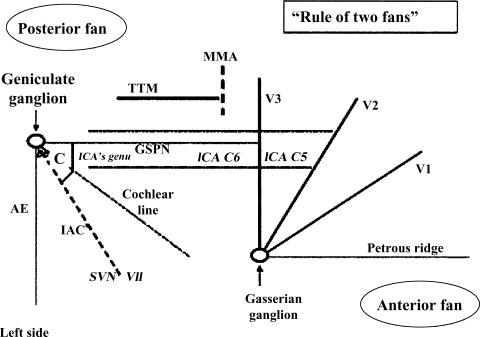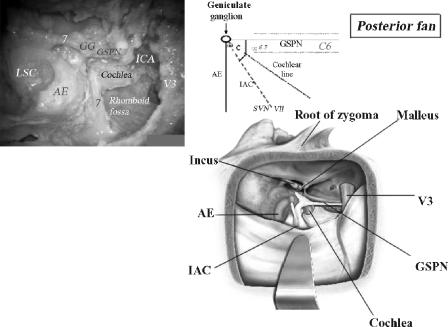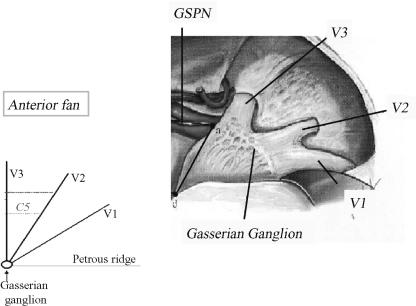ABSTRACT
The extradural middle fossa approach is used to access lesions of the petroclival and cavernous sinus regions. It may be included in combined petrosal and anterolateral transcavernous approaches. Technically, it is a demanding exposure that provides a wide extradural corridor between the 5th, 7th, and 8th cranial nerves. Its major advantages are that it offers extradural dissection, limits temporal lobe retraction, and avoids the transposition of nerves or vessels. Its disadvantages are primarily related to the complicated anatomy of the petrous apex from the middle fossa trajectory, which can be unfamiliar to neurosurgeons. To facilitate the first attempts with this relatively uncommon approach during dissections of human cadaveric injected heads and isolated temporal bones, we developed a simple learning method useful for localizing all anatomical structures. Using this “rule of two fans,” vascular, nervous, fibrous, and osseous structures are localized within two bordering fans with a 90-degree relationship to each other.
Keywords: Anatomy, cavernous sinus, cranial base surgery, middle fossa approach, petrous temporal bone
The middle fossa approach is an extradural subtemporal route consisting of an anterior petrosectomy. The most relevant indications for this approach are intradural lesions medial to the trigeminal nerve and ventral to the internal auditory canal (IAC), including IAC pathology, mostly in patients with normal hearing.1
Combined with a mastoidectomy, retrosigmoid, suboccipital, and supramastoid drilling, the middle fossa approach is a fundamental step of the combined petrosal approach. It is useful for exposure of the petroclival area, medial cerebellopontine angle (CPA), and posterior cavernous sinus.2,3 The most common indications for the combined petrosal approach are sphenopetroclival tumors, removal of neoplasms with a transtentorial (supra- and infratentorial) extension, and vertebrobasilar aneurysms.1,2,3,4,5,6,7,8
The anterior extension of this approach is the so-called extended middle fossa approach. This approach is indicated for intradural lesions of the superior CPA and prepontine clivus (retroclival lesions, ventral brainstem tumors, and cavernomas), bypasses at the C6 level of the internal carotid artery (ICA) (Kawase's triangle of the cavernous sinus), and cavernous sinus lesions.1,3 To simplify the recognition of anatomical structures during this technically demanding approach, we developed a simple learning method from cadaveric dissections. We hope this method will be useful for young neurosurgeons performing their first middle fossa approaches.
MATERIAL AND METHODS
The work was performed in the Skull Base Microdissection Laboratory of Anspach Company in West Palm Beach (FL), in the Carolina Neuroscience Institute for Skull Base Surgery Temporal Bone Laboratory (Raleigh, NC), in the University of Morgantown Skull Base Microdissection Laboratory (WV), and in the University of Roma “La Sapienza” Temporal Bone Laboratory (Castel Romano, Roma, Italy) during single dissections and skull base courses.
Fifteen fixed human cadaveric heads and 20 isolated temporal bones were dissected to yield 50 sides studied. As described in a previous article,2 a rhomboid-shaped construct of middle fossa landmarks served as a guide to maximize removal of the petrous apex. Four points define this construct: (1) the junction of the greater superficial petrosal nerve (GSPN) and trigeminal nerve branches (V1, V2, V3); (2) the lateral edge of the porus trigeminus; (3) the intersection of the petrous ridge and arcuate eminence (AE); and (4) the intersection of the GSPN, geniculate ganglion, and AE. Maximal bone removal was extended inferiorly beyond the inferior petrosal sinus to the clivus; posteriorly for unroofing the IAC; laterally for skeletonizing the geniculate ganglion, GSPN, and ICA; and anteriorly under the gasserian ganglion. The ICA was followed to the petrous apex. A simple geometric construct helps locate the cochlea. After the middle meningeal artery is sectioned, identification of the dura propria is the key step for dissection and exposure of all anatomical structures.
To identify and skeletonize all nervous, vascular, fibrous, and osseous structures involved in this lateral skull base approach, two fans bordering each other with a 90-degree relationship have been schematically identified (Fig. 1). The base of the posterior fan (Fig. 2) can be considered the geniculate ganglion, whereas the base of the anterior fan (Fig. 3) is the gasserian ganglion.
Figure 1.
Illustration showing the rule of two fans: vascular, nervous, fibrous, and osseous structures are localized within the two bordering fans (posterior and anterior) positioned at a right angle to each other.
Figure 2.
The base of the posterior fan is the geniculate ganglion. Its rays are the AE, IAC, cochlear line (an ideal line passing through the cochlea), and GSPN. AE, arcuate eminence; IAC, internal auditory canal; GSPN, greater superficial petrosal nerve.
Figure 3.
The base of the anterior fan is the gasserian ganglion. Its rays are V3, V2, V1, and the petrous ridge.
Proceeding in posteroanterior and mediolateral directions, the rays of the posterior fan are the AE, IAC, cochlear line (an ideal line passing through the cochlea), and GSPN. According to Fukushima's classification,1 the cochlea lies in a plane deeper than the IAC and GSPN, in front of the “genu” (loop) between the C6 and C7 segments of the ICA.
Proceeding in posteroanterior and lateromedial directions, the rays of the anterior fan are the third (V3), second (V2), and first (V1) branches of the trigeminal nerve and the petrous ridge. The two fans form the boundaries of the “rhomboid” fossa as follows: (1) the GSPN-V3 junction, (2) the lateral edge of the porus trigeminus, (3) the intersection of the petrous ridge and AE, and (4) the intersection of the GSPN-AE.1,2
The C6 segment of the ICA lies under the GSPN. The C5 segment is under V2–V3, and the C3–C4 segments are under the oculomotor and trochlear nerves (near the superior orbital fissure). The cochlea, labyrinth, ICA, and cranial nerves 5 through 8 are all at risk during drilling and dissection.1,2,5,6,7 Therefore, this technique must be practiced in the cadaver laboratory before clinical cases are performed.
CONCLUSIONS
When performed properly, this technique provides a solid adjunct to treating complex skull base lesions. Although the anatomical landmarks of the lateral skull base are well known, the simple “rule” that we propose simplifies the recognition of vascular, nervous, osseous, and fibrous structures during a middle fossa dissection and approach. Practice with cadavers is mandatory for all neurosurgeons, especially for those unfamiliar with this approach.
REFERENCES
- Sameshima T, Mastronardi L, Friedman A, Fukushima T eds, editor. Middle fossa dissection for extended middle fossa and anterior petrosectomy. Fukushima's Microanatomy and Dissection of the Temporal Bone for Surgery of Acoustic Neuroma and Petroclival Meningioma. Raleigh, NC: AF Neurovideo Publisher; 2004. pp. 49–76.
- Day J D, Fukushima T, Giannotta S L. Microanatomical study of the extradural middle fossa approach to the petroclival and posterior cavernous sinus region: description of the rhomboid construct. Neurosurgery. 1994;34:1009–1016. doi: 10.1227/00006123-199406000-00009. [DOI] [PubMed] [Google Scholar]
- Inoue T, Rhoton A L, Jr, Theele D, Barry M E. Surgical approaches to the cavernous sinus: a microsurgical study. Neurosurgery. 1990;26:903–932. doi: 10.1097/00006123-199006000-00001. [DOI] [PubMed] [Google Scholar]
- Al-Mefty O, Ayoubi S, Gaber E. Trigeminal schwannomas: removal of dumbbell-shaped tumors through the expanded Meckel cave and outcomes of cranial nerve function. J Neurosurg. 2002;96:453–463. doi: 10.3171/jns.2002.96.3.0453. [DOI] [PubMed] [Google Scholar]
- Day J D, Fukushima T, Giannotta S L. Innovations in surgical approach: lateral cranial base approaches. Clin Neurosurg. 1996;43:72–90. [PubMed] [Google Scholar]
- Day J D, Kellogg J X, Tschabitscher M, Fukushima T. Surface and superficial surgical anatomy of the posterolateral cranial base: significance for surgical planning and approach. Neurosurgery. 1996;38:1079–1083. [PubMed] [Google Scholar]
- Day J D, Fukushima T. The surgical management of trigeminal neuromas. Neurosurgery. 1998;42:233–240. doi: 10.1097/00006123-199802000-00015. [DOI] [PubMed] [Google Scholar]
- Samii M, Migliori M M, Tatagiba M, Babu R. Surgical treatment of trigeminal schwannomas. J Neurosurg. 1995;82:711–718. doi: 10.3171/jns.1995.82.5.0711. [DOI] [PubMed] [Google Scholar]





